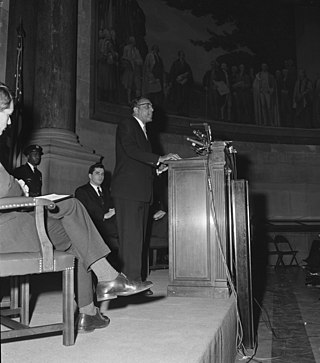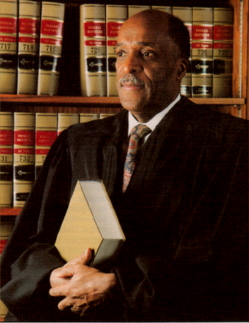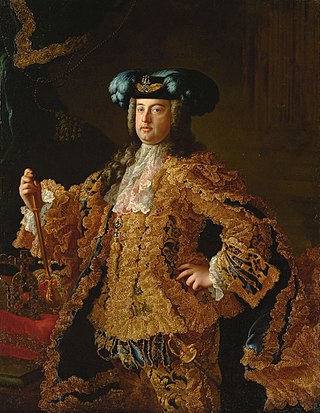Related Research Articles

Garrett Augustus Morgan Sr. was an American inventor, businessman, and community leader. His most notable inventions were a type of three-way traffic light, and a protective 'smoke hood' notably used in a 1916 tunnel construction disaster rescue. Morgan also discovered and developed a chemical hair-processing and straightening solution. He created a successful company called "G. A. Morgan Hair Refining Company" based on his hair product inventions along with a complete line of haircare products and became involved in the civic and political advancement of African Americans, especially in and around Cleveland, Ohio.

William Joseph Seymour was a Holiness Pentecostal preacher who initiated the Azusa Street Revival, an influential event in the rise of the Pentecostal and Charismatic movements, particularly Holiness Pentecostalism. He was the second of eight children born in an African-American family to emancipated slaves.

Theodore Moody Berry was an American politician of the Charter Party of Cincinnati, Ohio and was the first African-American mayor of Cincinnati, Ohio.

George Washington Williams was a soldier in the American Civil War and in Mexico before becoming a Baptist minister, politician, lawyer, journalist, and writer on African-American history. He served in the Ohio House of Representatives.

Charles Harris Wesley was an American historian, educator, minister, and author. He published more than 15 books on African-American history, taught for decades at Howard University, and served as president of Wilberforce University, and founding president of Central State University, both in Ohio.

Nathaniel Raphael Jones was an American attorney, judge, and law professor. As general counsel of the NAACP, Jones fought to end school segregation, including in the northern United States. From 1979 until 1995, he served as a United States circuit judge of the United States Court of Appeals for the Sixth Circuit before assuming senior status, and in 2002 retired to resume a private legal practice.

J. R. Clifford was West Virginia's first African-American attorney. Clifford was also a newspaper publisher, editor and writer, school teacher, and principal. He was a Civil War veteran, grandfather, as well as a civil rights pioneer and founding member of the Niagara Movement. Despite boundaries derived from racial discrimination, Clifford's accomplishments were great, reflecting his ability and determination.

Norris Wright Cuney was an American politician, businessman, union leader, and advocate for the rights of African-Americans in Texas. Following the American Civil War, he became active in Galveston politics, serving as an alderman and a national Republican delegate. He was appointed as United States Collector of Customs in 1889 in Galveston. Cuney had the highest-ranking appointed position of any African American in the late 19th-century South. He was a member of the Union League and helped attract black voters to the Republican Party; in the 1890s, more than 100,000 blacks were voting in Texas.

The Grand Lodge of Ohio, formally known as the Grand Lodge of Free & Accepted Masons of Ohio, is the governing body of the largest group of Masonic lodges in Ohio. The Grand Lodge of Ohio follows the Anglo-American tradition of Freemasonry that is common in the United States. In 2023, the Grand Lodge reported a total membership of 75,000 Master Masons.

Wade Hampton Ellis was a Republican politician in the U.S. state of Ohio who served as Ohio Attorney General (1904–1908), then Special Assistant to the Attorney General of the United States (1909–1911) and special counsel to the U.S. Department of Justice where he gained fame as a trust buster before resuming a private practice. The United States Supreme Court also appointed Ellis as special master in the case of Massachusetts v. New York. While splitting his time between Washington, D.C., and Cincinnati, Ohio, Ellis acquired and restored Rippon Lodge, which proved to be built by his ancestors and which a descendant placed on the National Register for Historic Places
The Most Worshipful National Grand Lodge Free & Accepted Ancient York Masons Prince Hall Origin National Compact USA is a body of Masonry in the United States of America composed predominantly of African American Freemasons. It governs Grand Lodges within the United States and the Commonwealth of The Bahamas.

William Dominick Matthews was an African-American abolitionist, Civil War Union officer and Freemason. He was leader in Leavenworth, Kansas, as well as nationally.
The Most Worshipful Smooth Ashlar Grand Lodge F&AAYM is a subordinate Masonic Grand Lodge of the Most Worshipful National Grand Lodge of Free and Accepted Ancient York Masons Prince Hall Origin - National Compact in and for the State of Georgia. Through it subordination to the National Grand Lodge, Smooth Ashlar Grand Lodge has lineage to African Lodge No. 459.

In Freemasonry, a Mason at sight, or Mason on sight, is a non-Mason who has been initiated into Freemasonry and raised to the degree of Master Mason through a special application of the power of a Grand Master.
Wendell Phillips Dabney was an influential civil rights organizer, author, and musician as well as a newspaper editor and publisher in Cincinnati, Ohio. He wrote various books and pamphlets including Cincinnati's Colored Citizens.

James McHenry Jones was an American educator, school administrator, businessperson, and minister. Jones was the third principal of the West Virginia Colored Institute from 1898 until 1909 and is considered by West Virginia State as the institution's third president.
Alexander Harris (1818–1909) was an African-American deacon, trustee, interim pastor of the First Bryan Baptist Church and one of the most powerful African-American religious and civil leaders in Savannah, Georgia during the end of the 19th century and beginning of the 20th century.
Gaines High School was a high school for African Americans and also later served as a normal school training teachers in Cincinnati, Ohio. It opened in 1866 and was named for school board member John I. Gaines, an advocate of schools for African Americans in Ohio. It was one of Ohio's first public high schools for African Americans. Peter H. Clark and then William H. Parham served as its principals. The year of the school's closure is uncertain; sources say 1887 or 1890. A historical marker commemorates the school.
References
- 1 2 3 4 5 6 7 "Colored Leader Taken by Death". newspaperarchive.com. Jul 10, 1904. p. 10. Retrieved 17 July 2021.

- 1 2 "William H. Parham | Ohio Statehouse". www.ohiostatehouse.org.blocked the EU
- ↑ "ohiohistory.org / The African American Experience in Ohio, 1850-1920 / Cleveland Gazette". dbs.ohiohistory.org.
- ↑ Parham, William (1906). "An official history of the Most Worshipful Grand Lodge, Free and Accepted Masons for the State of Ohio". [Lodge?]. Retrieved 17 July 2021.
- ↑ "Criticised M'Kinley". The Marion Star. 16 August 1899. p. 2. Retrieved 17 July 2021.
- 1 2 "Wm. H. Parham Dead". The Cincinnati Enquirer. 10 July 1904. p. 24. Retrieved 17 July 2021.